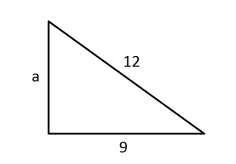Наши популярные онлайн курсы
I wanted to start with some typical math problems in school:
- Two cars started from the same point, at 5 am, travelling in opposite directions at 40 and 50 mph respectively. At what time will they be 450 miles apart?
- At 9 am a car (A) began a journey from a point, travelling at 40 mph. At 10 am another car (B) started travelling from the same point at 60 mph in the same direction as car (A). At what time will car B pass car A?
Or how about a geometry problem:
- Find the length of the unknown side, a, of the right triangle below.

- A rectangle has an area of 96cm2. The width is four less than the length. What is the perimeter?
What’s wrong with those problems?
Let’s take this problem as an example: At 9 am a car (A) began a journey from a point, travelling at 40 mph. At 10 am another car (B) started travelling from the same point at 60 mph in the same direction as car (A). At what time will car B pass car A?
What is the answer? Most kids and their teachers would tell you it’s 12pm. Sure… in an academic world. What’s the probability that car B would pass car A at exactly 12pm in real life? It’s close to zero of course. Traffic jams, punctured tires, accidents, weather, none of that exists in the academic world.
Our kids are taught that problems have precise single possible solutions. Every problem in school must have a single correct answer. Nothing could be further from the truth in reality.
What should we be teaching our kids?
We need to teach kids about uncertainty and optionality. Being alive means making decisions under uncertainty, something that kids in school are completely unprepared. The real life rarely, if ever, has a single correct answer, there are usually multiple good choices and multiple bad choices. Uncertainty needs to be appreciated, not ignored.
Many years ago I wrote a chapter for the Ministry of Finance sponsored high-school textbook on risk management. Now that I have kids of my own, I think I will start teaching probabilistic thinking and optionality much earlier.

































